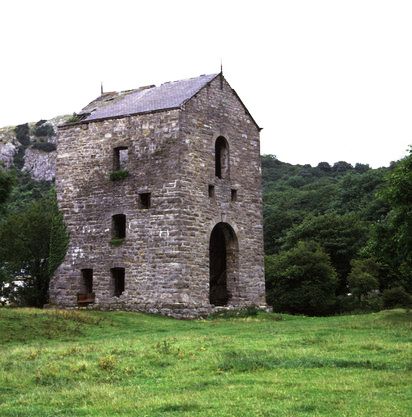
Talargoch Mine, engine house on Clive shaft
Copyright © Chris Allen
and licensed for reuse under this Creative Commons Licence
This large mine, near Prestatyn, was at the north-west corner of the Flintshire orefield. The veins were in limestone, sandstone and chert which were covered by up to 200 feet of saturated gravel and other drift deposits. This made shaft sinking difficult and the mine very wet.
Mining began on the hill of Graig Fawr in the 1630s and by the end of the century this cheaply won ore was nearing exhaustion. There was, therefore, a move to working the water laden Talargoch Vein. Various small grants were made, but in 1753 Paul Panton and the Rev. Thomas Ince began acquiring leases on the vein. Daniel Seaman, of Flint, and Thomas Smedley, of Bagilt, took the adjoining sett and in 1763 agreed with Panton to collaborate in working the two mines. Both companies made losses until 1775, when output grew and the mine went into profit.
For very much of the 18th century the mine was drained using waterwheels, but increasing problems with way-leaves for water supplies, plus advances in steam technology, led to the increasing use of steam power in the 19th century.
Clive Shaft, at the southern end of the mine, was sunk between 1842 and 1845. It was fitted with a hydraulic engine, but it began to struggle with the inflow of water and was replaced by a 100 inch Cornish engine in 1860. There was also an 80 inch engine and thirteen smaller ones.
The main bottom level, serving the entire mine, was at 220 yards, but it cut heavy inflows of water in a number of places and so by June 1882 most of the southern end was closed and work was concentrated around Mostyn Shaft, at the north end. The ore here continued down to the 360 yard level in the limestone, but the vein’s continuation was soon cut off by Vale of Clwyd Fault. This was only a temporary reprieve, therefore, and, with low lead prices, the mine closed in May 1884 and was allowed to flood. Earlier figures are not available, but between 1845 and 1884 Talargoch produced 57,752 tons of lead ore and 49,810 tons of zinc blende.
Thorburn, J.A. Talargoch Mine (British Mining No.31, 1986)
Return to previous page
